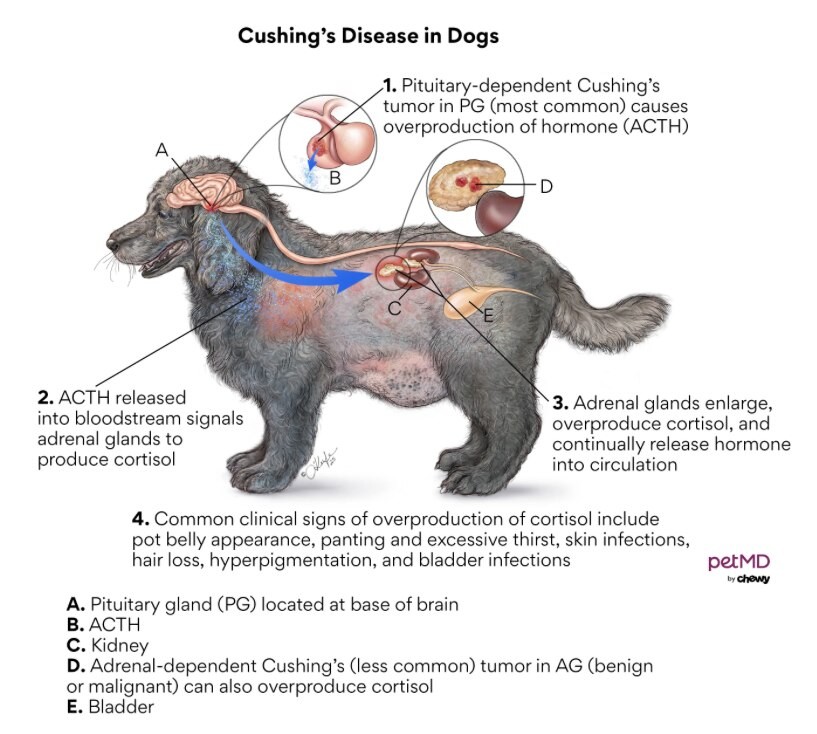Cushing’s disease, also known as hyperadrenocorticism, is a serious endocrine disorder that primarily affects middle-aged and senior dogs. This condition arises from the overproduction of cortisol, a vital hormone, and if left unmanaged, it can significantly impact your dog’s health and well-being. This article will delve into what is Cushing’s disease in dogs, covering its types, symptoms, causes, diagnosis, and treatment options available.
Understanding Cushing’s Disease in Dogs
Cushing’s disease in dogs, or hyperadrenocorticism, is characterized by the excessive production of cortisol. Cortisol is a steroid hormone produced by the adrenal glands, which are located near the kidneys. This hormone plays a crucial role in regulating various bodily functions, including the immune system, metabolism, and response to stress. When the body produces too much cortisol, it can lead to a range of health problems.
The pituitary and adrenal glands are central to understanding Cushing’s disease. The pituitary gland, a small, pea-sized gland at the base of the brain, produces adrenocorticotropic hormone (ACTH). ACTH stimulates the adrenal glands to produce and release cortisol. In a healthy dog, a feedback loop ensures that cortisol production is regulated. However, in dogs with Cushing’s disease, this feedback mechanism malfunctions, resulting in the adrenal glands producing excessive cortisol, even when it’s not needed.
Types of Cushing’s Disease
There are primarily two types of Cushing’s disease in dogs:
- Pituitary-dependent Cushing’s disease: This is the most common form, accounting for approximately 80-85% of cases. It is caused by a tumor (usually benign) on the pituitary gland, leading to the overproduction of ACTH. This excess ACTH, in turn, stimulates the adrenal glands to produce too much cortisol.
- Adrenal-dependent Cushing’s disease: This type occurs when a tumor develops on one or both of the adrenal glands themselves. These tumors can be either benign (adenomas) or malignant (carcinomas). The tumor secretes excessive amounts of cortisol, independent of ACTH stimulation from the pituitary gland.
Recognizing the Symptoms of Cushing’s Disease in Dogs
The elevated cortisol levels associated with Cushing’s disease can manifest in several noticeable ways. Common symptoms include:
- Increased thirst (polydipsia) and urination (polyuria): Affected dogs often drink excessively and, consequently, urinate much more frequently.
- Increased appetite (polyphagia): Dogs with Cushing’s disease often exhibit a ravenous appetite and may seem constantly hungry.
- Potbelly appearance: This is a characteristic sign, where the abdomen becomes enlarged and pendulous due to weakened abdominal muscles and redistribution of fat.
- Excessive panting: Even at rest or in cool environments, dogs with Cushing’s may pant heavily.
- Lethargy: A decrease in energy levels and increased sleepiness are common.
- Skin problems: These can include thinning skin, hair loss (especially on the trunk), and increased susceptibility to skin infections.
- Muscle weakness: The breakdown of muscle tissue can lead to weakness, particularly in the hind limbs.
- Calcified skin (calcinosis cutis): Hardened tissue growth or hard lumps underneath the skin
What Causes Cushing’s Disease?
The specific cause of Cushing’s disease depends on the type:
- Pituitary-dependent Cushing’s: Usually caused by a benign tumor (adenoma) on the pituitary gland. This tumor secretes excessive ACTH, leading to overstimulation of the adrenal glands.
- Adrenal-dependent Cushing’s: Can be caused by either a benign (adenoma) or malignant (carcinoma) tumor on one or both adrenal glands. These tumors directly produce excessive cortisol.
- Iatrogenic Cushing’s disease: This form is caused by the prolonged use of corticosteroids, such as prednisone, to treat other medical conditions. The excessive administration of these medications mimics the effects of Cushing’s disease.
Certain breeds, such as Poodles, Yorkshire Terriers, and Dachshunds, appear to be predisposed to developing Cushing’s disease, suggesting a genetic component may play a role.
How Veterinarians Diagnose Cushing’s Disease in Dogs
Diagnosing Cushing’s disease can be challenging as its symptoms can mimic other conditions. A veterinarian will typically start with a thorough physical examination and a detailed discussion of your dog’s medical history and symptoms. If Cushing’s disease is suspected, specific diagnostic tests will be performed:
- Low-Dose Dexamethasone Suppression (LDDS) Test: This test measures cortisol levels before and after administering a low dose of dexamethasone, a corticosteroid. In healthy dogs, dexamethasone suppresses cortisol production. However, in dogs with Cushing’s disease, cortisol levels remain elevated.
- ACTH Stimulation Test: This test measures cortisol levels before and after administering synthetic ACTH. In dogs with Cushing’s disease, the adrenal glands overreact to ACTH stimulation, resulting in a significant increase in cortisol levels.
- Urine Cortisol:Creatinine Ratio (UCCR): This is a screening test that can help rule out Cushing’s disease. It measures the amount of cortisol in the urine relative to creatinine. An elevated UCCR suggests the possibility of Cushing’s disease, but further testing is needed for confirmation.
To differentiate between pituitary-dependent and adrenal-dependent Cushing’s disease, additional tests may be performed, including:
- High-Dose Dexamethasone Suppression (HDDS) Test: This test is similar to the LDDS test but uses a higher dose of dexamethasone. It can help differentiate between pituitary-dependent and adrenal-dependent Cushing’s disease, as some dogs with pituitary-dependent disease will show suppression of cortisol at the higher dose.
- Abdominal Ultrasound: This imaging technique can help visualize the adrenal glands and identify any tumors.
- Computed Tomography (CT) Scan or Magnetic Resonance Imaging (MRI): These advanced imaging techniques provide more detailed views of the pituitary and adrenal glands, helping to identify tumors and assess their size and location.
Routine blood work and urinalysis are also important to assess the dog’s overall health and identify any other underlying conditions.
Treatment Options for Cushing’s Disease
The treatment approach for Cushing’s disease depends on the type and severity of the condition.
- Medication: The most common treatment for both pituitary-dependent and adrenal-dependent Cushing’s disease is medication. The two most commonly used drugs are:
- Trilostane: This medication inhibits the production of cortisol in the adrenal glands. It is generally considered the first-line treatment for Cushing’s disease in dogs.
- Mitotane (Lysodren): This medication selectively destroys cortisol-producing cells in the adrenal glands. It is less commonly used than trilostane due to its potential for more significant side effects.
- Surgery: In cases of adrenal-dependent Cushing’s disease where a single adrenal tumor is present, surgical removal of the affected adrenal gland may be an option. Surgery is more invasive than medication but can potentially provide a cure.
- Radiation Therapy: For pituitary-dependent Cushing’s disease, radiation therapy can be used to shrink the pituitary tumor. However, this treatment is not widely available and may have potential side effects.
- Dietary Management: A low-fat diet is often recommended for dogs with Cushing’s disease, as they tend to have elevated cholesterol and triglyceride levels.
Managing Cushing’s Disease in Dogs
While Cushing’s disease is not preventable in most cases, iatrogenic Cushing’s disease can be avoided by carefully monitoring dogs on long-term corticosteroid therapy.
Dogs diagnosed with Cushing’s disease require lifelong monitoring to ensure that the medication dosage is appropriate and that the disease is well-controlled. This typically involves regular veterinary checkups, blood tests, and ACTH stimulation tests.
It’s important to follow your veterinarian’s recommendations closely and report any changes in your dog’s condition promptly. With proper management, dogs with Cushing’s disease can live a good quality of life.
FAQs about Cushing’s Disease in Dogs
What is the life expectancy of a dog with Cushing’s disease?
The life expectancy of a dog with Cushing’s disease varies depending on the type of disease, the severity of symptoms, and the response to treatment. With appropriate management, many dogs can live for several years after diagnosis.
What is the ideal diet for a dog with Cushing’s disease?
A low-fat diet is generally recommended for dogs with Cushing’s disease to help manage elevated cholesterol and triglyceride levels.
Are there natural remedies for Cushing’s disease in dogs?
There are no scientifically proven natural remedies for Cushing’s disease in dogs. Medical treatment with medication or surgery is necessary to manage the condition effectively.
How often should my dog be tested for Cushing’s management?
Dogs being treated for Cushing’s disease typically need to be monitored every few months to ensure the medication dosage is appropriate and that the disease is well-controlled. Your veterinarian will determine the appropriate monitoring schedule based on your dog’s individual needs.
References
- Cushing’s syndrome. (2024, January 19). Cornell University College of Veterinary Medicine. https://www.vet.cornell.edu/departments/riney-canine-health-center/canine-health-information/cushings-syndrome

